Sprint workouts are one of the fastest ways to burn fat, build power, and increase your overall athletic performance.
Unlike steady-state cardio, sprinting engages your fast-twitch muscle fibers — boosting metabolism, improving endurance, and sculpting lean muscle in less time.

According to the Journal of Strength and Conditioning Research (2024), high-intensity sprint training can elevate post-exercise calorie burn (EPOC) for up to 24 hours, making it one of the most effective methods for fat loss and conditioning.
Whether you train on a track, treadmill, bike, or hill, sprint workouts challenge your cardiovascular system and fast-twitch fibers — giving you both speed and definition.
Below, we’ve outlined 15 of the best sprint workouts to help you burn fat, build power, and boost speed fast — all backed by science and real-world results.
Why Sprint Workouts Work
Sprint workouts involve short bursts of all-out effort followed by recovery periods.
They train your anaerobic system, helping you burn fat, build strength, and improve speed in less time.
Each sprint lasts 10–60 seconds at near-max effort, followed by rest or light movement.
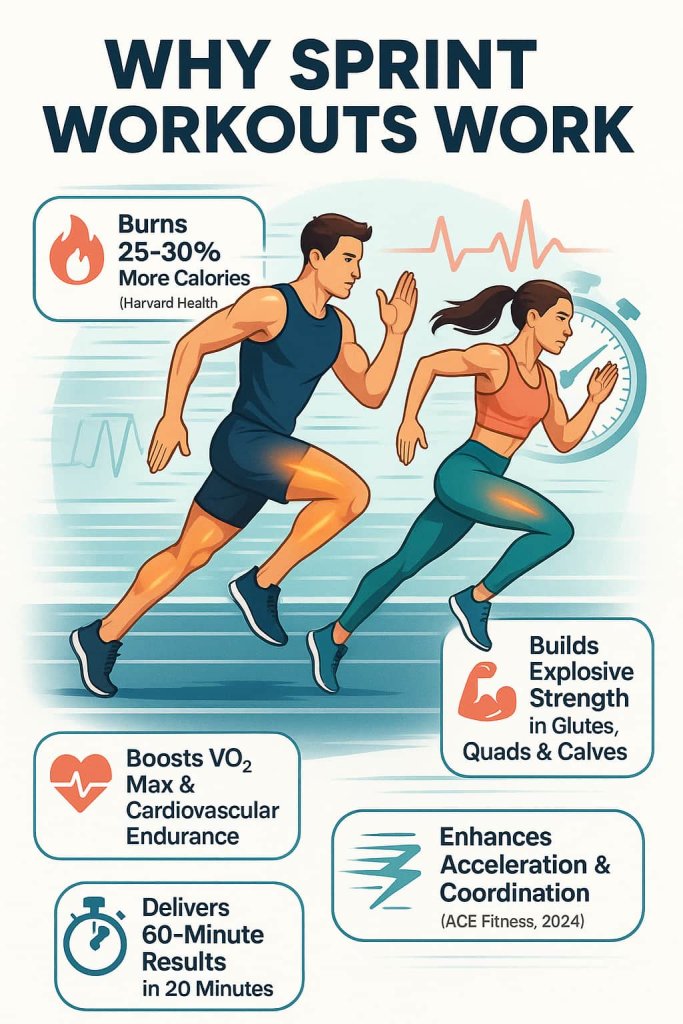
Sprinting isn’t just about running fast — it’s about activating more muscle in less time.
Key Benefits:
- Accelerates fat loss: HIIT-style sprint sessions can burn up to 25–30% more calories than steady cardio (Harvard Health).
- Builds explosive power: Engages the glutes, hamstrings, quads, and calves for maximum force output.
- Improves cardiovascular endurance: Boosts VO₂ max and heart efficiency.
- Enhances athletic performance: Improves acceleration, coordination, and stride mechanics.
- ACE Fitness notes that HIIT can deliver many of the same benefits as a 60–90-minute steady-state cardio session in far less time.
How to Structure Your Sprint Training
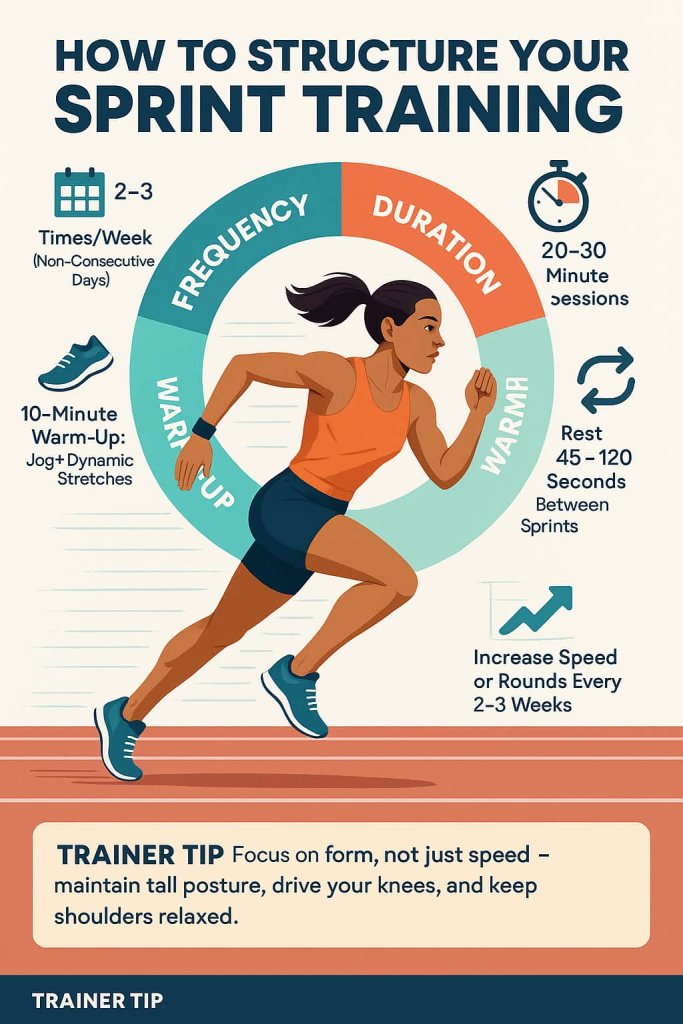
Frequency: 2–3 times per week (non-consecutive days)
Session Duration: 20–30 minutes
Warm-Up: 10 minutes of light jogging + dynamic stretches
Rest Between Sprints: 45–120 seconds (based on intensity)
Progression: Gradually increase speed or number of rounds every 2–3 weeks
Trainer Tip: Always focus on form, not just speed. Sprint with tall posture, drive your knees, and relax your shoulders to avoid injury.
15 Best Sprint Workouts
These 15 sprint workouts combine fat-burning intensity with performance-driven training.
Each session boosts endurance, builds explosive lower-body power, and rapidly improves overall speed and conditioning.
1. Track Sprint Intervals
Why it works:
Track sprints train your anaerobic system — the body’s ability to generate power without relying on oxygen — which is essential for burning fat and improving cardiovascular efficiency. The repetitive acceleration and deceleration enhance stride mechanics, leg drive, and neuromuscular coordination. Over time, this increases both top-end speed and endurance.
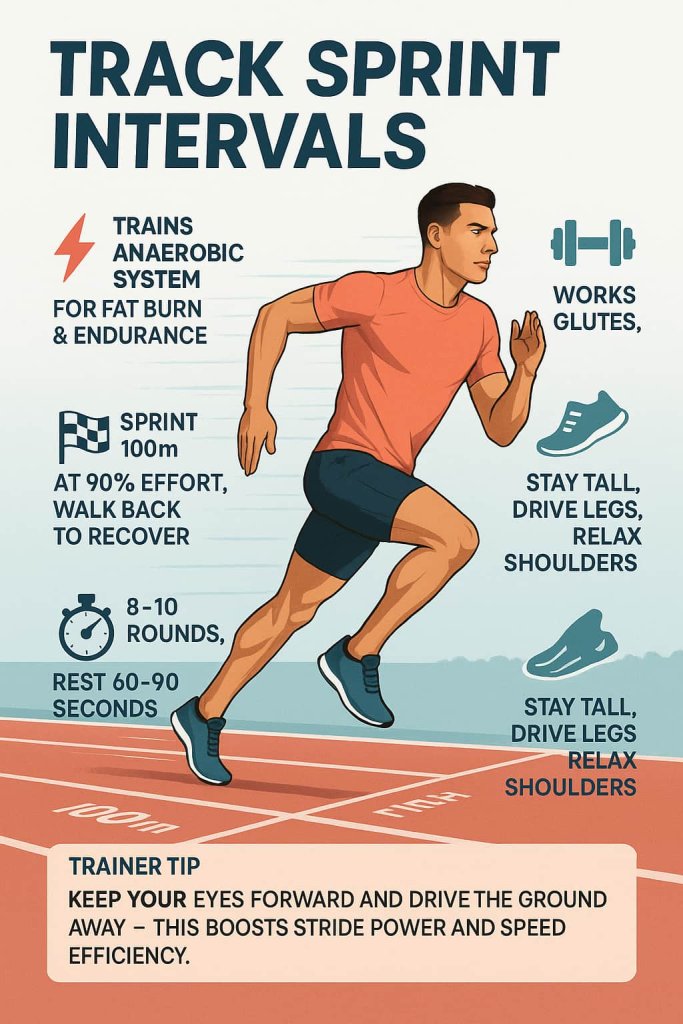
Muscles worked:
Glutes, hamstrings, quads, calves, hip flexors, and core stabilizers.
How to do it:
- Sprint 100 meters at about 90% of your maximum speed.
- Focus on upright posture and relaxed arms.
- Walk back to the start as active recovery.
- Complete 8–10 rounds, resting 60–90 seconds between sprints.
Trainer Tip:
Keep your gaze forward and chin level. Imagine driving the track away from you rather than “pulling” yourself forward — this improves power output and stride frequency.
2. Hill Sprints
Why it works:
Sprinting uphill reduces impact stress while forcing your muscles to work harder against gravity. This not only builds lower-body power but also conditions your cardiovascular system to handle sustained effort.
Muscles worked:
Glutes, hamstrings, calves, quads, and spinal stabilizers.
How to do it:
- Locate a 20–40 meter hill with moderate incline.
- Sprint uphill for 20–30 seconds at near-maximum intensity.
- Walk or jog slowly back down for recovery.
- Perform 6–8 rounds.
Trainer Tip:
Keep your torso slightly leaning forward from the ankles (not the waist), pump your arms aggressively, and drive your knees high.
3. Treadmill Sprint Workout
Why it works:
Treadmill sprints allow precise control of speed and incline, making it easier to measure progress and intensity. They engage the same major leg muscles while minimizing environmental variables. The constant belt motion challenges balance and coordination — especially when performed at higher speeds.
Muscles worked:
Quads, glutes, hamstrings, calves, and core.
How to do it:
- Warm up for 5 minutes with light jogging.
- Set the treadmill speed to 8–10 mph (adjust to your level).
- Sprint for 30 seconds, then step off safely or slow to a walk for 60 seconds.
- Repeat 10–12 rounds.
Trainer Tip:
Avoid holding the rails — keep your core tight and arms pumping naturally. Use a 1–2% incline to better simulate outdoor running resistance.
4. 30-20-10 Sprint Protocol
Why it works:
This three-phase protocol ramps up intensity in a smooth gradient — activating aerobic, threshold, and anaerobic systems sequentially. It’s highly effective for improving endurance and fat oxidation while reducing injury risk from abrupt sprints.
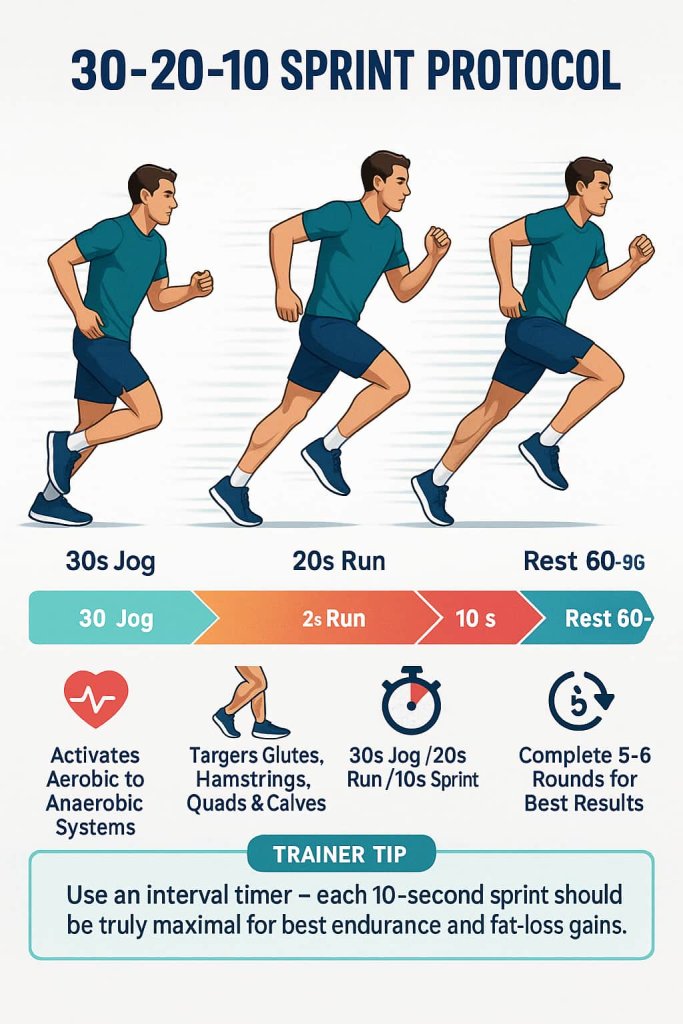
Muscles worked:
Lower-body muscle groups including glutes, hamstrings, quads, and calves.
How to do it:
- Jog lightly for 30 seconds.
- Run moderately for 20 seconds.
- Sprint all-out for 10 seconds.
- Rest 60–90 seconds.
- Repeat 5–6 rounds.
Trainer Tip:
Use a timer or interval app. The goal is consistency — each “10” should feel truly maximal, not rushed.
5. Pyramid Sprints
Why it works:
The pyramid format (short → long → short) progressively taxes both fast-twitch and slow-twitch muscle fibers. It trains your body to recover efficiently between varying durations — improving overall conditioning and pacing.
Muscles worked:
Glutes, hamstrings, quads, calves, and core.
How to do it:
- Sprint 10s → 20s → 30s → 40s → 30s → 20s → 10s.
- Rest 60 seconds between each sprint.
- Complete one full pyramid, rest 2 minutes, and repeat once if advanced.
Trainer Tip:
Don’t overpace your early sets — conserve energy to maintain strong technique throughout the longer intervals.
6. Flying Sprints
Why it works:
Flying sprints improve maximum velocity by focusing on relaxed acceleration and maintaining top speed. They enhance stride frequency, turnover rate, and neuromuscular efficiency — crucial for athletes seeking faster performance.
Muscles worked:
Hamstrings, glutes, hip flexors, calves, and obliques (for stability).
How to do it:
- Jog 20 meters to build speed gradually.
- Sprint all-out for 40 meters.
- Walk back for recovery.
- Repeat 6–8 rounds.
Trainer Tip:
Think “quick, light, and powerful.” Avoid stomping the ground — short ground contact time leads to faster acceleration.
7. Shuttle Sprints (Suicides)
Why it works:
Shuttle sprints develop agility, quick directional changes, and explosive recovery — mimicking real athletic movement. They also improve eccentric control as you decelerate and re-accelerate, reducing injury risk in dynamic sports.
Muscles worked:
Quads, glutes, hamstrings, calves, and hip adductors.
How to do it:
- Set up markers at 10m, 20m, and 30m.
- Sprint to 10m and back, then 20m and back, then 30m and back.
- Rest 60 seconds.
- Complete 4–6 rounds.
Trainer Tip:
Keep your hips low when changing direction and use short, controlled steps to stay balanced.
8. Resistance Sprints (Parachute or Band)
Why it works:
Resistance sprints overload the sprinting muscles, increasing force production and acceleration capability. Parachutes and bands simulate drag, engaging the posterior chain more effectively than unresisted sprints.
Muscles worked:
Glutes, quads, hamstrings, calves, and erector spinae.
How to do it:
- Attach a resistance parachute or band around your waist.
- Sprint 20–30 meters at near-max effort.
- Rest 90 seconds.
- Perform 6–8 rounds.
Trainer Tip:
Drive your knees forward with each step — resistance should never pull your torso backward.
9. Hill Bounding Sprints
Why it works:
Combining sprinting with bounding improves stride power, hip extension, and reactive strength. This plyometric-style training boosts vertical and horizontal force — ideal for athletes seeking power and speed.
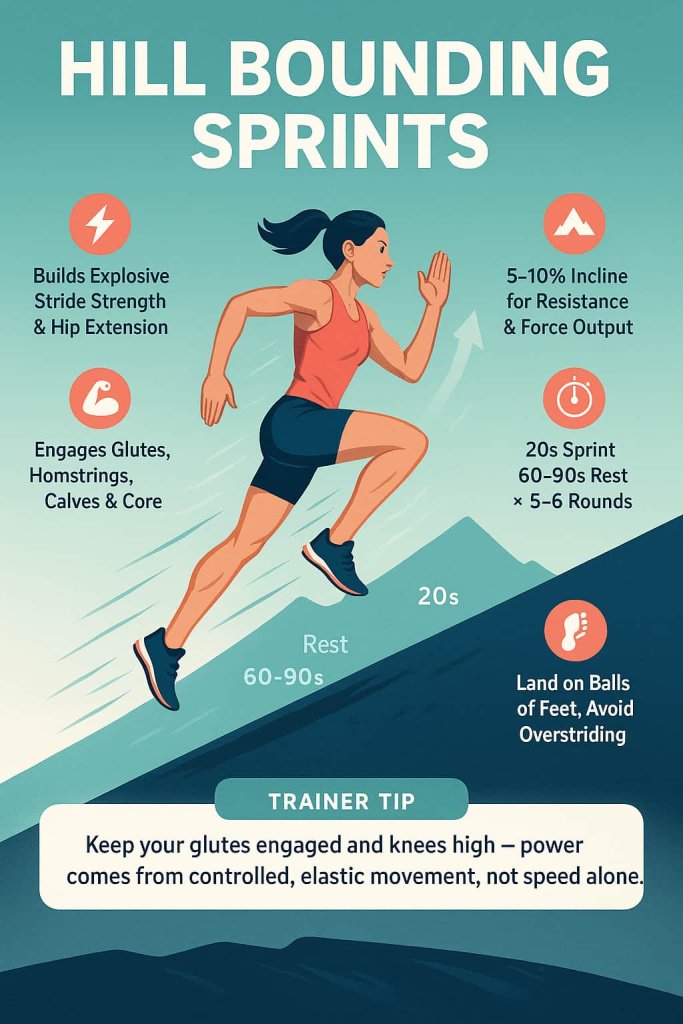
Muscles worked:
Glutes, hamstrings, hip flexors, calves, and core.
How to do it:
- Choose a hill with 5–10% incline.
- Sprint uphill with exaggerated, long strides for 20 seconds.
- Rest 60–90 seconds.
- Repeat 5–6 times.
Trainer Tip:
Land on the balls of your feet and engage your glutes — avoid overstriding or locking the knees.
10. Bike Sprints
Why it works:
Bike sprints elevate heart rate rapidly without the impact of running. This makes them perfect for joint-friendly conditioning and metabolic fat loss. The constant resistance challenges both muscular endurance and anaerobic capacity.
Muscles worked:
Quads, hamstrings, glutes, calves, and hip flexors.
How to do it:
- Pedal hard for 15 seconds at max effort.
- Slow pedal for 45 seconds.
- Repeat 10–15 rounds.
Trainer Tip:
Keep your cadence smooth — avoid jerky pedaling. Maintain upright posture for better breathing efficiency.
11. Sand Sprints
Why it works:
Running on sand requires 1.5x more energy expenditure due to surface instability. It improves balance, ankle strength, and muscular endurance while being gentle on joints.
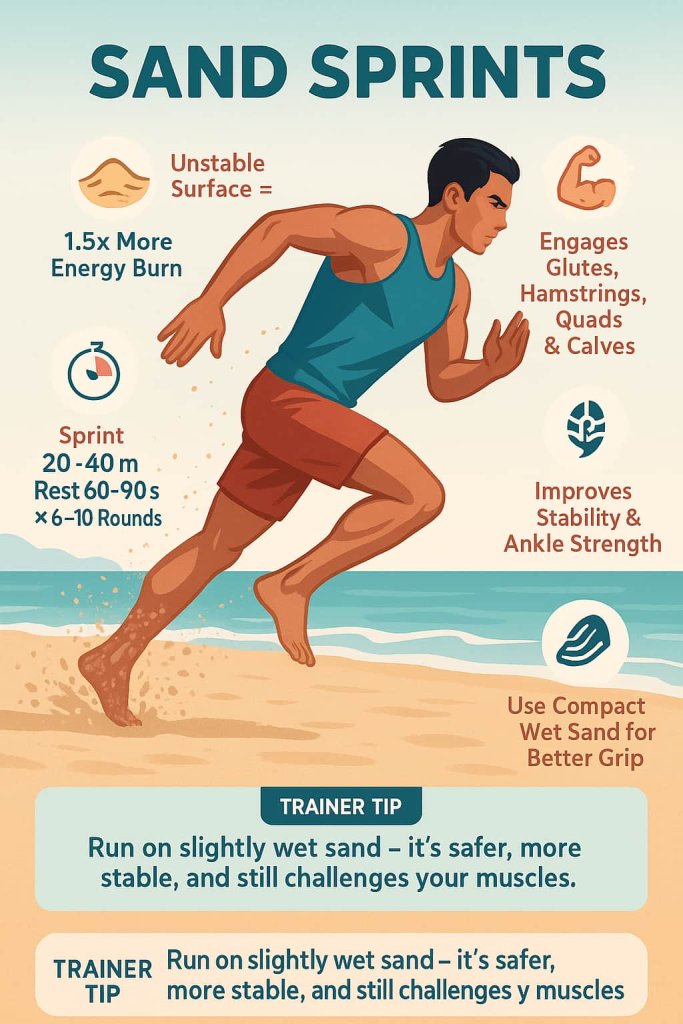
Muscles worked:
Calves, hamstrings, glutes, quads, and stabilizing muscles around ankles and knees.
How to do it:
- Sprint 20–40 meters on sand at 85–100% effort.
- Rest 60–90 seconds.
- Repeat 6–10 times.
Trainer Tip:
Avoid deep, dry sand — slightly wet, compact sand provides better traction and safety.
12. Weighted Sled Sprints
Why it works:
Sled sprints develop raw acceleration by training the ability to produce horizontal force. This translates to faster starts, stronger legs, and higher explosive output.
Muscles worked:
Glutes, hamstrings, quads, calves, and core stabilizers.
How to do it:
- Load a sled with 25–40% of your bodyweight.
- Push or pull it for 20 meters at maximum effort.
- Rest 60–90 seconds.
- Repeat 6–8 times.
Trainer Tip:
Maintain a 45° body lean, drive through your legs, and keep the core engaged. Avoid lifting your heels mid-drive.
13. 10 × 100m Speed Session
Why it works:
Repeated 100-meter sprints improve speed endurance — your ability to maintain high velocity over time. This type of training enhances recovery capacity and overall running efficiency.
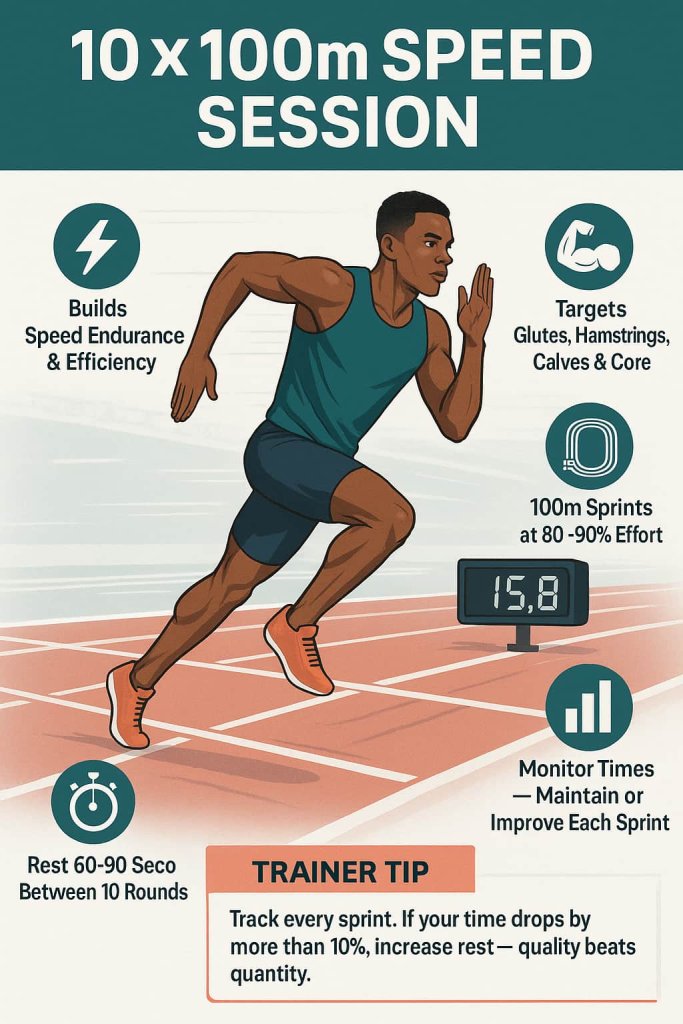
Muscles worked:
Glutes, hamstrings, calves, hip flexors, and obliques.
How to do it:
- Sprint 100 meters at 80–90% effort.
- Rest 60–90 seconds between each run.
- Complete 10 rounds.
Trainer Tip:
Track each sprint time — consistent or improving times indicate progress. If you slow down by more than 10%, extend your rest.
14. 60-Second Sprint Challenge
Why it works:
A full-minute sprint engages both aerobic and anaerobic systems, improving stamina and lactic threshold. This workout also enhances mental toughness as you sustain near-max effort beyond comfort.
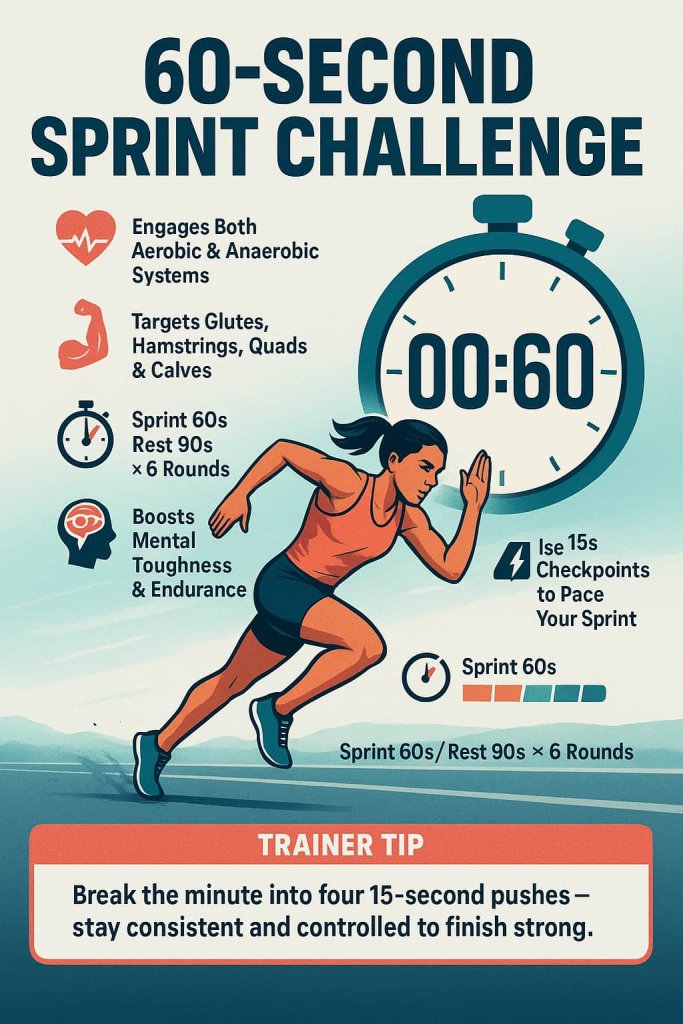
Muscles worked:
Glutes, hamstrings, quads, calves, core, and heart.
How to do it:
- Sprint at 85–95% effort for 60 seconds.
- Walk or rest for 90 seconds.
- Complete 6 rounds.
Trainer Tip:
Break the minute into mental checkpoints (15s each) to maintain effort — pacing is key to lasting all rounds.
15. Tabata Sprint Circuit
Why it works:
This science-backed HIIT method (20s on / 10s off) triggers massive EPOC — your body continues burning calories long after the session ends. It enhances VO₂ max, endurance, and muscular efficiency in just four minutes.
Muscles worked:
Glutes, hamstrings, calves, quads, and cardiovascular system.
How to do it:
- Sprint 20 seconds at all-out effort.
- Rest 10 seconds.
- Repeat 8 rounds (4 minutes total).
- Rest 2 minutes and repeat 2–3 cycles if advanced.
Trainer Tip:
Use a timer and go full intensity on every 20-second burst. Short intervals mean every second counts — treat each sprint like it’s the last.
Sample Weekly Sprint Workout Plan
| Day | Focus | Workout |
|---|---|---|
| Monday | Speed | 10 × 100m Track Sprints |
| Wednesday | Strength | Hill or Sled Sprints |
| Friday | Fat Burn | Tabata or 30-20-10 Sprint Circuit |
| Sunday | Recovery | Light jog or mobility session |
Health and Safety Considerations Before You Start
Sprints are high intensity — so proper preparation is key.
- Warm up 8–10 minutes before every session.
- Rest 48 hours between sprint days to recover.
- Train on safe, even surfaces with supportive shoes.
- Stop if you feel pain, dizziness, or chest discomfort.
- Consult a doctor before starting if you have heart, joint, or metabolic conditions.
Finish every workout with a cool-down and stretching to protect your muscles and joints.
Trainer Tip: Start slow, focus on form, and increase speed gradually for safe long-term progress.
Disclaimer: This content is for informational purposes only and not medical advice. Consult a qualified healthcare professional before starting high-intensity exercise, especially if you have heart, joint, or metabolic conditions.
FAQs
1. Are sprint workouts good for fat loss?
Yes. Sprinting triggers EPOC, which boosts calorie burn even after your workout ends.
2. Can beginners do sprint workouts?
Yes, but start with shorter distances or lower-intensity runs. Focus on form before speed.
3. How many sprint workouts should I do per week?
2–3 sessions are enough for most people; balance with rest and strength training.
4. How long should a sprint last?
Each sprint typically lasts 10–60 seconds depending on your fitness goal.
5. Can I sprint on a treadmill?
Yes — treadmill sprints are effective for controlled intensity and weather-proof workouts.
6. Do sprint workouts build muscle?
Yes. Sprinting recruits large muscle groups like glutes, quads, and hamstrings, promoting lean muscle gain.
7. Should I eat before a sprint workout?
Eat a light meal or snack with carbs and protein 1–2 hours before for energy and recovery.
Conclusion
Sprint workouts are an unbeatable way to burn fat, boost speed, and build explosive power — all in less time than traditional cardio. Whether you train on a track, treadmill, or hill, consistency and intensity are key.
Start with two sessions a week, focus on proper form, and push your limits gradually for long-term results.
Ready to level up your fitness? Try one of these sprint workouts this week and experience the difference in your performance and physique.
References
- Tabata protocol (foundational HIIT evidence) — Tabata I, et al. “Effects of moderate-intensity endurance and high-intensity intermittent training on anaerobic capacity and VO₂max.” Med Sci Sports Exerc. 1996.
https://pubmed.ncbi.nlm.nih.gov/8897392/ - VO₂max gains from HIIT (meta-analysis) — Bacon AP, et al. “VO₂max response to high-intensity interval training: a meta-analysis.” PLoS One. 2013.
https://journals.plos.org/plosone/article?id=10.1371/journal.pone.0073182 - Programming & practical applications of HIIT — Buchheit M, Laursen PB. “High-Intensity Interval Training—Part II: Practical applications.” Sports Med. 2013.
https://link.springer.com/article/10.1007/s40279-013-0067-1 - EPOC (afterburn) and intensity/duration — LaForgia J, Withers RT, Gore CJ. “Effects of exercise intensity and duration on EPOC.” J Sports Sci. 2006.
https://www.tandfonline.com/doi/abs/10.1080/02640410600552064 - Sprint mechanics & power for individualized training — Morin J-B, Samozino P. “Interpreting power-force-velocity profiles for individualized sprint training.” Sports Med. 2016.
https://link.springer.com/article/10.1007/s40279-016-0414-4 - Mayo Clinic — High-intensity interval training (HIIT): benefits and cautions
https://www.mayoclinic.org/healthy-lifestyle/fitness/in-depth/high-intensity-interval-training/art-20046356
